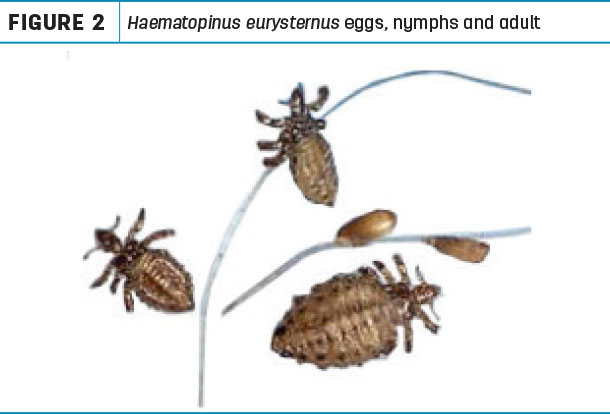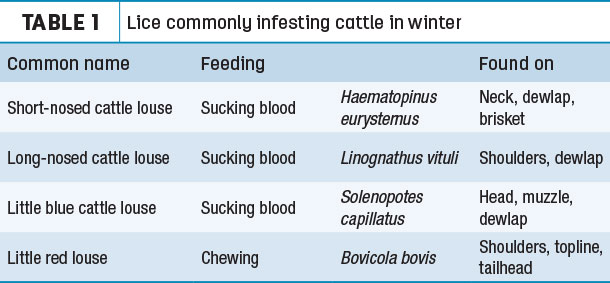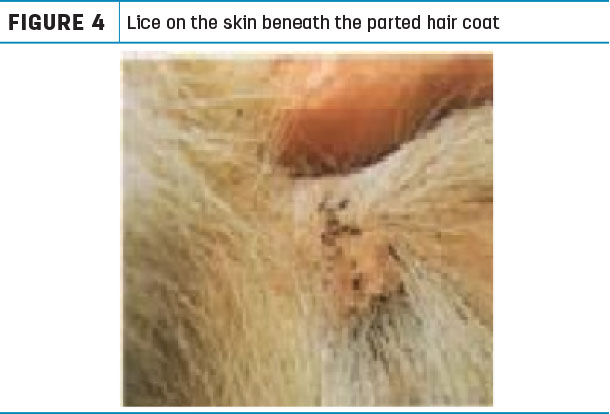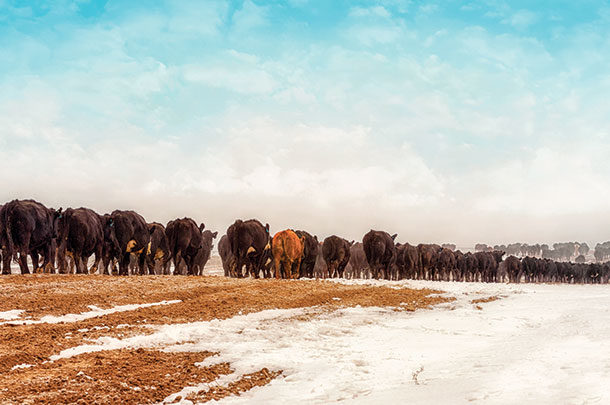This marks the beginning of a lice season that will peak during January and February.
To understand what happens, let’s take a quick look at the lice life cycle (Figure 1) because there are several key points to consider.

First, lice spend their entire life cycle on the animal and spread from animal to animal by direct contact, so lice control must happen on the animal. Many people wonder if lice can survive in a wad of hair on a post or fence for short periods of time, resulting in lice transfer to a new animal, but those bugs won’t live in that environment for very long if at all.
This means it’s important to prevent any direct contact between treated and untreated cattle to prevent reinfestation of treated animals. Most cattle-handling facilities are not designed to prevent any direct contact. For example, cattle driving alleys and pens are separated by only one fence, so there is potential for through-the-fence contact between a pen of treated cattle and untreated animals in the alley. Another example is treatment of sick cattle in a hospital pen environment, resulting in commingling of treated and untreated animals.
Second, the life cycle is approximately three weeks long in cool weather. If a female louse (Figure 2) lays an egg, called a nit (Figure 3) on the hair of an animal today, it will hatch in the next three to seven days to nymph.

That nymph then matures to an adult louse in seven to 10 days. That adult begins laying eggs in about seven days. From those numbers, it is apparent that 21 days after application of a product that only kills adults, a reinfestation will occur from the eggs.

Also, because a female louse lays approximately 40 eggs during her life, and the life cycle is 21 days long, if one does the math, a single adult female on an animal in September can result in approximately a million lice in January. That’s a severe herd infestation that will result in many animals scratching and rubbing on any solid object.
There are four species of lice involved in winter cattle lice infestations, and each of the species has a somewhat different area of the animal’s body where they like to hang out. Therefore, it is important to apply lice treatments so they cover the body as much as possible so lice come in contact with the small amount of product being applied, especially with pyrethroid products that are not absorbed into the body.

The labels on most products recommended for lice control indicate they should be applied along the back line from withers to tailhead, and most pyrethroid products indicate some should be applied to the poll or down the face. That may add a degree of difficulty when treating animals, but it is critical for good lice control.
Another way to assist in the distribution of the product is to apply half the amount from withers to middle of the back and the other half from tailhead to middle of the back. Thus, there are two lines of product applied that meet in the middle of the animal’s back. In addition, product should be applied as close to the midline of the back as possible so product flows down both sides of the animal.
In short, applying all the product in one spot in the middle of the back will not be effective in controlling lice.
How can lice be controlled?
The first step in lice control is examination of a few animals to make an accurate diagnosis. To do this, put an animal in the chute, part the hair between your fingers and watch for the lice movement on the skin (Figure 4).

A LED headlamp helps the visibility of the lice as they move away from the area. Do this examination in six to eight areas on the head, neck, shoulders and along the back line on both sides of the animal. Examine several animals and take note of the number of lice seen at each location. Finding three to five lice per hair part is an indication of an infestation that needs treatment. Also, be aware: Lice may not be seen on animals that have been treated, and other things such as mange can cause animals to scratch.
Because lice eggs are not susceptible to most insecticide treatments, consideration must be given to products that include both an insecticide and an insect growth regulator. These products have the advantage of killing adult lice and preventing the hatching of eggs, so one application controls all stages of lice.
A second method is to apply lice control to kill adult parasites and follow that with a second treatment 14 to 21 days later to kill the newly hatched lice before they begin laying eggs. It is critical the second treatment be applied within those time limits to prevent the newly hatched lice from laying eggs and continuing the infestation, as described above.
Lice control products come in many forms such as pour-ons, sprays, dusts and oilers. The most commonly used is the pour-on, but many producers use other treatment methods to supplement lice control. For example, dust bags or oilers can be effectively used during the winter, and even sprays can be used on warm winter days.
In summary, remember the keys to lice control:
- Begin by applying a lice control product according to label directions early in the lice season but after temperatures are cooler and hair coats have begun to grow so lice are reproducing.
- Be sure to follow the manufacturer’s directions for applying the product so it is properly distributed over the animal.
- Keep treated animals from being reinfested with lice from untreated animals.
- Monitor animals through the winter and re-treat them if lice are found before the infestation is severe.
- Plan to apply a winter, pre-calving treatment for better late-season control.
Your veterinarian can help you develop a program that is right for your herd and with planning ways to prevent reinfestation.
Finally, use a lice control product if lice control is the goal. Use endectocides to target internal parasites, and don’t use them for lice control, to prevent the selection for resistant internal parasites when the goal is to kill lice. ![]()
PHOTO: There are four species of lice involved in winter cattle lice infestations, and each of the species has a somewhat different area of the animal’s body where they like to hang out. Therefore, it is important to apply lice treatments so they cover the body as much as possible so lice come in contact with the small amount of product being applied … Getty images.

-
Larry Hawkins
- Senior Technical Services Veterinarian
- Bayer HealthCare LLC
- Email Larry Hawkins












